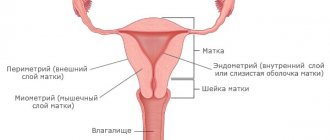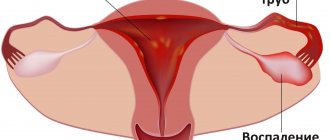The term “vulvitis” refers to inflammation of the vulva - the external female genital organs. The main symptoms that make you seek help from a gynecologist are severe itching and discharge of various types. After the first signs of the disease appear, it is necessary to immediately diagnose and begin treatment. Vulvitis in women with an advanced course will lead to the spread of the process in an ascending way to all genital organs. When the vulva and vagina are affected, they speak of the development of vulvovaginitis (colpitis).
Causes of vulvitis
Vulvitis is a disease that affects the external genitalia. Most often it occurs due to changes in the vaginal microflora. This phenomenon may be caused by the following reasons:
- sexual infections;
- decreased immunity;
- obesity;
- fungal or viral infections;
- lack of personal hygiene;
- microcracks;
- cystitis;
- inflammatory process in the ovaries;
- cancerous tumors;
- decreased estrogen activity;
- helminthiasis;
- injuries.
Anesthetic ointments for vulvitis
Have you been fighting thrush for many years without success?
Head of the Institute: “You will be amazed at how easy it is to cure thrush by taking it every day.
Vulvitis is a very common disease among the fair sex. Vulvitis is characterized by irritation and itching in the area of the external genitalia. With this disease, painful sensations during urination, walking, and sexual intercourse are common. Inflammation can occur for various reasons. The main causative agent of thrush is the Candida fungus.
Our readers successfully use Candiston to treat thrush. Seeing how popular this product is, we decided to bring it to your attention. Read more here...
Why is it dangerous?
The symptoms of vulvitis of different nature are similar. However, different forms of candidal vulvitis require different treatments, so it is extremely important to diagnose the nature of the disease in a timely manner.
Inflammation, which is a consequence of the activity of fungi, is especially dangerous for children and adolescents, since during this period vulvitis can spread to the vaginal area, causing vulvovaginitis, fusion of the labia minora and even infertility. In mature women, advanced forms of inflammation often lead to deformation of the genital organs, which makes sexual intercourse difficult, and sometimes even makes it impossible.
How to tell the difference?
Vulvitis of candidal origin is different:
- Itching, burning and painful sensations in the labia, preclitoral area, inner thighs, perianal area. A typical symptom of the candidiasis form of the disease is an exacerbation of itching in the days before menstruation and easing immediately after it.
- Changes in the color of the skin of the genital organs - from purple to bluish.
- Vesicles and small rashes, which, when opened, form erosions, small spots with skin peeling off along the edges.
- Whitish discharge, similar to cottage cheese.
In most cases, candidal vulvitis is a companion to thrush. Irritation occurs due to secretions and waste products of fungal pathogens.
Forms of the disease
There are several clinical forms of candidal inflammation. Vulvitis can be subacute or acute catarrhal-membranous; chronic catarrhal, leukoplakiform, kraurosis-like, as well as asymptomatic and mixed candidiasis-bacterial.
This disease is dangerous, first of all, because it easily takes on a chronic form. Advanced vulvitis is characterized by infiltration and hyperemia of the mucous membranes of the outer surface of the genital organs, dryness and lichenification of the labia, a whitish coating, swelling, itching, and hyperfunction of the sebaceous glands. With symptomatic treatment, relapses may occur with greater frequency.
In the case of acute forms of inflammation, bed rest is often prescribed, with strict implementation of all treatment procedures and the complete exclusion of sexual contact.
Treatment
Often, especially in folk medicine, vulvitis is treated symptomatically. You need to understand that this approach can lead to a chronic form of the disease and constant relapses.
The best results are obtained from complex treatment of vulvitis with antibacterial, immunostimulating and local therapy.
For almost all forms of the disease, washing the vulva and labia with antibacterial solutions, douching with potassium permanganate or boric acid, and anesthetic ointments are prescribed.
For candidal forms, the use of antifungal vaginal suppositories is mandatory. Sometimes antihistamines are also prescribed. The duration of treatment ranges from 10 to 14 days.
Traditional methods of treatment
Candidal inflammation, like other vulvitis, requires professional diagnosis and complex therapy. In addition to medications, you can use folk recipes that will help relieve symptoms of the disease and speed up recovery.
Thus, it is recommended to use warm sitz baths prepared with a decoction of medicinal herbs - chamomile, St. John's wort, calendula, string. You can wash with a weak (light pink) solution of potassium permanganate or diluted decoctions of medicinal plants.
Remember that self-medication poses a great danger to your health! Do not use any home remedies to treat candida vulvitis without consulting your doctor!
All about candidal vulvitis Link to main publication
results
Poll Options are limited because JavaScript is disabled in your browser.
You or from your IP have already Ali.
You or from your IP have already Ali.
- Contacts
- User Agreement for the use of the Site
What drugs are best for treating thrush in women?
Candidiasis is an infection of the mucous membrane of the vulva, vagina, and urinary tract by fungi of the genus Candida. The pathogen is widespread in the environment; a person can get it not only from a sexual partner, but also through any household items, touching, kissing, eating, etc.
The occurrence of thrush
The problem is quite relevant, even in our age of progressive pharmacology. The pathogen changes its properties, acquires resistance, people actively help it with this, self-medicating and rejecting traditional methods.
In addition, candida can be classified as a “disease of civilization.” Beautiful synthetic underwear, tight trousers, which have become especially popular among women, synthetic detergents, panty liners, lubricants, aggressive antibiotics, junk food, and much more that has entered our lives thanks to progress, actually makes life much more difficult for people.
Synthetic underwear, tight clothing, pads create conditions of high humidity and temperature, disrupt the blood circulation of the genital organs, detergents, lubricants change the balance of flora, and can contribute to chemical injury to the mucous membrane, its drying out, and the development of a local allergic reaction. Antibiotics suppress the growth of the body's own microflora, leading to increased reproduction of candida.
Well, how unhealthy nutrition affects the body has, of course, been said more than once. But, as you know, repetition... When the body, especially women, does not receive enough of the necessary macro and microelements, vitamins, the flow of biological processes is disrupted, metabolism, the synthesis of protective cells, enzymes, etc. are disrupted, which leads to disturbances in local and humoral (general) immunity.
When all the described changes occur and unpleasant symptoms appear, it would be good to know what is currently being used to treat thrush in women. Remedies for thrush in women are presented in a wide range, but only the attending doctor can advise what is best to take.
Drug treatment of thrush in women
There is a fairly impressive list of effective medications against thrush for women, both for oral, local, and external use.
Source: https://UziMaster.ru/anestezirujushhie-mazi-pri-vulvite/
Classification and symptoms of the disease
Vulvitis in women (pictured) has unpleasant symptoms, which depend on the form of the disease, and it is better to start treatment at the first signs. There are these types of diseases:
- Candida. It is characterized by swelling of the labia, itching, burning, cheesy discharge, the appearance of ulcers, erosions and lumpy plaque. Easily eliminated at the initial stage of occurrence.
- Atrophic. With this type of disease, painful erosions and point inflammation appear. It is necessary to eliminate the symptoms of atrophic vulvitis in women and begin the treatment process in a comprehensive manner, starting with increasing immunity.
- Allergic. This type often occurs in little girls and teenagers. Characterized by burning, itching and inflammation. Therapy consists of suppressing the allergen.
- Bacterial. Caused by the herpes virus, gonococci, tuberculosis bacteria, trichomonas and chlamydia.
Depending on the form of vulvitis, it can be acute or chronic. Signs of acute illness:
- swelling of the vulva;
- itching and burning;
- bloody, watery or purulent discharge;
- pain that gets worse when walking and sitting;
- weakness;
- enlarged lymph nodes.
The chronic form does not have significant symptoms.
Complications of the disease
In the absence of necessary therapy, vulvitis can cause the following complications:
- the appearance of chronic ulcers;
- vaginal fusion;
- the appearance of scars;
- infection of the internal genital organs;
- cystitis;
- infertility;
- urethritis;
- cervical erosion.
Hormonal ointments
Why does vulvitis bother girls so often? In a nutshell, the functioning of the mucous membrane of the genital organs is ensured by female hormones - estrogens. They begin to be secreted in sufficient quantities by the ovaries only after the onset of regular menstruation. Until this age, the child’s perineum is exposed to various infections, irritation with washing products, sweat, etc.
Pediatric gynecologists note that almost 50% of girls under the age of 2 have synechiae, fusion of the labia minora. In most cases, this type of vulvitis goes away on its own. This disease requires treatment only if the fusion interferes with the normal flow of urine. For this purpose, an ointment containing estrogen is used.
«>
Treatment at home
Vulvitis in women can be treated at home if detected early and sought medical help. Traditional healers offer easy-to-prepare but effective recipes:
- St. John's wort decoction. For 500 ml of water you need to take 2 tbsp. l. raw materials and boil for 5 minutes. After cooling, you can strain and use it for hygienic washing of the genitals before bed. St. John's wort is also used to treat and relieve unpleasant symptoms of colpitis in women.
- Herbal decoction. Take and mix the plant mixture thoroughly: 3 tbsp. l. nettle, 1 tbsp. l. chamomile, 5 tbsp. l. knotweed. For a liter of water you need to take 2 tbsp. l. this collection and boil for 10 minutes, after half an hour, strain. Take 100 ml orally in the morning, at lunch and before dinner for 3 months.
- Oak decoction. This decoction is used for hygienic washing of the genitals twice a day. Grind oak bark (2 tbsp), add boiling water (1 l) and simmer in a water bath for 5 minutes, strain after cooling. Oak bark is one of the folk remedies that is used in the treatment of cervical erosion.
- Viburnum decoction. 2 tbsp. l. pour boiling water (500 ml) over the viburnum flowers and simmer in a water bath for 12 minutes; after cooling, it is necessary to filter. Take 15 ml before each meal. Viburnum is also used to relieve the symptoms of menopause in women and to treat diseases associated with this age and condition.
- Herbal infusion No. 1. Mix 1 tbsp. l. marshmallow roots, 6 tbsp. l. oak bark and 4 tbsp. l. oregano. Brew 4 tbsp in a thermos. l. this collection with a liter of boiled water, leave for 12 hours and strain. For vulvitis, drink 100 ml before meals.
- Herbal infusion No. 2. For herbal collection, take and mix thoroughly 3 tbsp. l. stinging nettle and mantle, 2 tbsp. l. lemon balm leaves and valerian roots. 4 tbsp. l. pour boiling water (1 liter) over the collection and leave in a thermos for 5 hours. Take the medicine in the same way as the first infusion.
- Herbal infusion No. 3. This medicinal infusion is used for vaginal douching in the morning and before bed. Take 0.5 tablespoons of chamomile flowers and oak bark, 1.5 tbsp. l. stinging nettle and 2 tbsp. l. knotweed. Infuse the mixture in a liter of boiling water until it cools, then strain. For one-time douching 2 tbsp. l. dilute with a liter of warm water.
- Herbal infusion No. 4. This infusion is also used for vulvitis for douching in the morning and evening. Mix 1.5 tbsp. l. dried cucumbers and celandine, 1 tbsp. l. calendula flowers, tansy, chamomile, cinquefoil grass and plantain leaves. Pour boiling water (500 ml) into the mixture and leave for 3 hours, then filter.
- Stinging nettle juice. Squeeze the juice from fresh herbs and drink 5 ml three times a day.
- Honey tampons. They make special tampons soaked in honey and leave them on for 12 hours for 15 days.
- Potassium permanganate solution. Prepare a slightly pink solution for a sitz bath or wash.
- Soda solution. Used for vulvitis for douching and washing. In a liter of water, stir 20 g of soda and 5 ml of iodine. You need to douche twice a day for two weeks.
Healers recommend avoiding spicy and salty foods while taking medications, and also abstain from sexual intercourse.
Antifungal
Vulvitis of fungal origin is caused by Candida yeast. In the treatment of the disease, drugs of various forms are used, but ointments are the most convenient, because they act directly on the source of the pathology, without affecting other organs. Ointments, unlike suppositories, can be prescribed not only to women, but also to girls who are not yet sexually active. When prescribing a medicine for external use, the doctor explains how to use it.
The most popular antifungal ointments are the following:
- Clotrimazole. The ointment destroys yeast cells. Its use can be twofold: application to the affected areas or insertion into the vagina. In the first case, treatment lasts up to 2 weeks, in the second the result is visible after 3 days. But when administered intravaginally, the medicine can cause complications in the form of itching and mucous discharge.
- Pimafucin. The active ingredient of the drug is natamycin. This is an antimycotic that has a negative effect on Candida fungi. Apply 4 times a day. The duration of the treatment course is selected by the doctor individually for each patient. After the clinical symptoms disappear, the ointment should be used for another 4 days. The drug does not cause side effects, so it is prescribed to pregnant and lactating women. Pimafucin is approved for use by patients of any age.
- Candide. The ointment has fungicidal and antibacterial effects. Apply to the genitals 2-3 times a day. Therapy lasts up to 2 weeks. The drug is contraindicated for pregnant women (in the 1st trimester) and those who are allergic to any component included in the ointment.
- Nystatin. Vulvitis can be treated with this ointment for 7–10 days. If the pathology is chronic, then the duration of the course is extended to 1 month. The medicine is prescribed as a prophylactic agent for antibacterial therapy and for chronic fungal infections.
Before using any external medicine, it is necessary to clean the genitals, for example, by treating them with antiseptic drugs. The ointment is carefully applied to the affected areas of the vulva. If complications occur (itching, swelling), you must stop using the medicine and consult a doctor. The doctor will select another medication.
Disease prevention
To avoid getting vulvitis, you should follow simple rules:
- Hygienic procedures should be carried out using special hygienic gels and foams. Dry yourself with a sterile individual towel.
- Choose the right underwear. It should be made from natural fibers and fit your size.
- Treat inflammation in your body in a timely manner.
- Lead a healthy and active lifestyle, play sports.
- Eat properly and balanced.
- Strengthen immunity.
- Get rid of bad habits.
- Avoid unprotected casual sex.
- At the first symptoms of the disease, begin timely treatment.
Dear readers, have you encountered vulvitis? What folk remedies were used to treat it. We are waiting for your proven recipes and recommendations.











